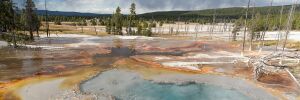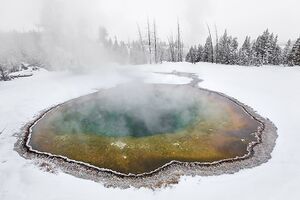Microbial organisms in Yellowstone: Difference between revisions
No edit summary |
No edit summary |
||
| Line 24: | Line 24: | ||
<br> The repeated citation works like this, with a forward slash.<ref name=aa/> | <br> The repeated citation works like this, with a forward slash.<ref name=aa/> | ||
Revision as of 01:07, 19 April 2022
Section

By Sydney Srnka
At right is a sample image insertion. It works for any image uploaded anywhere to MicrobeWiki.
The insertion code consists of:
Double brackets: [[
Filename: PHIL_1181_lores.jpg
Thumbnail status: |thumb|
Pixel size: |300px|
Placement on page: |right|
Legend/credit: Electron micrograph of the Ebola Zaire virus. This was the first photo ever taken of the virus, on 10/13/1976. By Dr. F.A. Murphy, now at U.C. Davis, then at the CDC. Every image requires a link to the source.
Closed double brackets: ]]
Other examples:
Bold
Italic
Subscript: H2O
Superscript: Fe3+
Sample citations:
A citation code consists of a hyperlinked reference within "ref" begin and end codes.
To repeat the citation for other statements, the reference needs to have a names: "Cite error: Closing </ref> missing for <ref> tag .Some of the interesting microorganisms include, but are not limited to; Thermophilic Bacteria, Thermus Aquaticus, Caldicellulosiruptor obsidiansis, Cyanobacteria, algae, mushrooms, fungi (ex. Curvularia protuberata), and Sulfolobus Acidocaldarius (3)(7). The Thermophilic bacteria that were first discovered in the hot springs of Yellowstone increased research on this type of bacteria and led to many more new discoveries on how these extremophiles were able to survive. Because Thermophilic bacteria are able to exist in extreme temperature and pH ranges, they became very popular organisms to study, especially because they have a variety of mechanisms that are not found in other cells that have been previously studied(2).

Thermophilic Organisms
Include some current research, with at least one figure showing data.
A large quantity of organisms residing in the superheated environments are classified as Thermophiles. These organisms fall under this classification because the name means heat lover (Thermo: Heat, Phile: Lover) and the environments they are mostly found in are superheated environments(3). Most Thermophiles fall under the bacteria and archaea domains however, there are a small number of eukaryotes that can be classified as thermophiles (4). Thermophilic bacteria can thrive in a range of water temperatures, some environments inhabited by thermophiles even surpass the boiling point of water (5). These bacteria have become a hot topic of research and study due to the adaptability of their metabolic processes and the process of their life functions.The reason they can survive in such conditions can be attributed to many factore, a few being that Thermophiles have adapted their proteins and DNA to be more stable and enzymes to function better in hotter environments. These adaptations are called thermo-adapted genes by scientists, and have been a recurring topic studied and researched for years (4). The determination and classification of the adaptations also leads to the study of how and why they are accumulated and passed on. Adaptation can happen by natural selection or random mutation, the ways the adaptations are passed on and spread through a colony of archaea or bacteria can be determined by studying the history of a specific gene. One method of the transfer of adapted genes is Horizontal Gene Transfer. Horizontal Gene transfer is the passing of a gene from parent to offspring. For example, one gene that is passed from parent to offspring in Thermophilic Archaea is the gene coding for the Reverse gyrase(4). The reverse gyrase topoisomerase helps with the DNA denaturation, it induces supercoiling of the double stranded DNA in order to increase the temperature in which the DNA can exist without denaturing or melting(4). This adaptation is one of the factors of thermophiles that allow them to live in such extreme conditions and environments. The thermophilic genome contains a wide variety of adaptations and mutations, yet is smaller than most prokaryotic genomes (4).

Extremophilic Organisms
Include some current research, with at least one figure showing data.
Morning Glory
Historical Findings
Conclusion
References
Authored for BIOL 238 Microbiology, taught by Joan Slonczewski, 2022, Kenyon College
